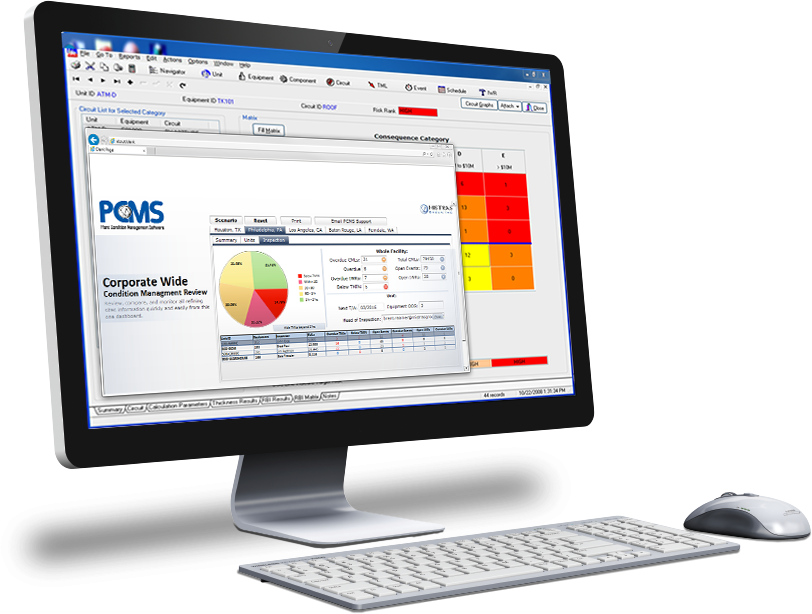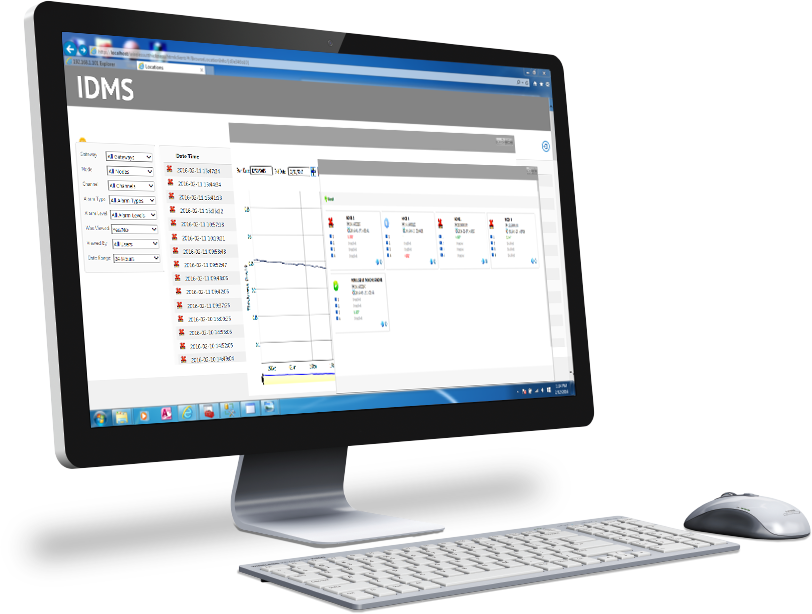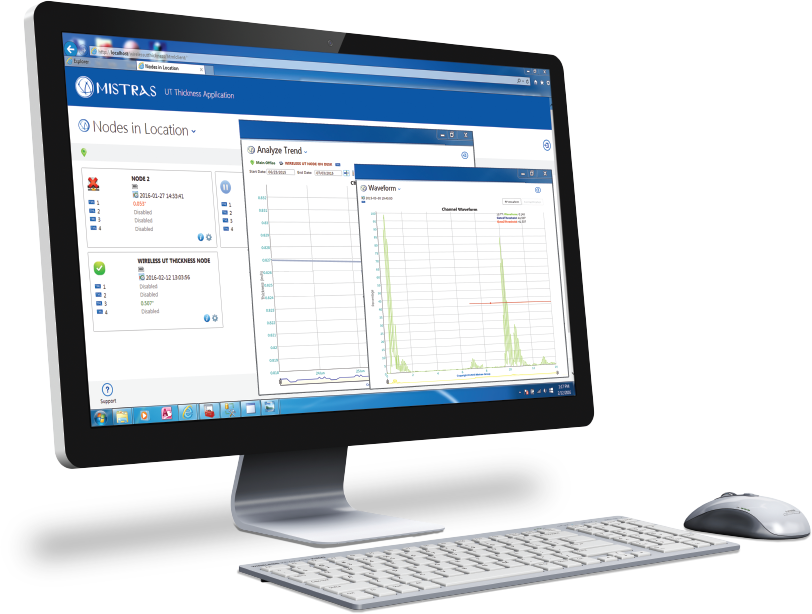Avoid Costly
Measures™
•
SAFER OPERATIONS
•
PRECISION ACCURACY
•
EASY INSTALL
•
WEB APP
•
IN LIEU OF MANUAL UTT
•
PCMS/IDMS EXPORT COMPATIBILITY
MISTRAS' CALIPERAY® is a permanently-mounted ultrasonic (UT) remote thickness tracking system used to monitor piping and vessel wall thickness in high-temperature and difficult-to-access locations.
MISTRAS CALIPERAY® | REMOTE THICKNESS TRACKING
AUTOMATED ULTRASONIC THICKNESS DATA ANALYSIS
High-temperature, hard-to-reach locations are not tested as often as they should be. Without adequate testing, plant operators have little-to-no warning of developing problems arising from corrosion and erosion – a costly surprise.
Traditional ultrasonic thickness testing (UTT) methods for determining corrosion and erosion on piping and vessel walls can be challenging to execute at times. It can often be difficult for technicians to access assets in potentially hazardous locations, and manual measurements have to contend with changes in surface conditions, technology and equipment.
MISTRAS' CALIPERAY® remote thickness tracking system makes it easy for operators to stay on top of their asset integrity and maintenance by utilizing permanently installed ultrasonic sensors to remotely, quickly and accurately monitor corrosion and erosion.
APPLICATIONS
- OVERHEAD LINES
- ReDucers
- ELBOWS
- PRESSURE VESSELS
- TEES
- AND MORE
Wireless Mesh
The thickness transducers make up a wireless mesh network. As they collect data from the piping or vessel walls, they both receive and transmit information through the rest of the network until it reaches the Smart Wireless Gateway, where it is then transferred to the host computer. The wireless mesh allows CALIPERAY® to seamlessly merge with on-site and remote network equipment.
The mesh network is self-healing and self-organizing, so if there is ever an interruption in the network, such as a temporary or even permanent obstacle, the transducers will simply find another path to the gateway. This smart sensor network makes it easier to install the network, streamlines the collection of data, and ensures higher reliability and lower maintenance.
Features & Benefits
Non-Intrusive Design and Installation
Highly Precise Readings
High-Temperature Functionality
Self-Organizing And Self-Healing Network
Decreased Reading Intervals
Improved Corrosion Management & Detection Equipment
Reduced Installation Costs
GREATER INSIGHT
CALIPERAY® provides more valuable insight into the condition of pipes over traditional methods. Once installed, CALIPERAY® monitors pipe wall thickness automatically, collecting data with a greater frequency and a higher accuracy than manual readings, because the permanent sensors remove many of the variables that create inconsistencies in manual readings. This data is transmitted wirelessly to a database, where it is stored for analysis through the CALIPERAY® Web App, PCMS, or other top-tier Integrated Database Management Software (IDMS).

By tracking changes to a pipe’s wall condition, CALIPERAY® provides a rich dataset, which helps operators make the right judgments on when to proactively take remedial action, and when to hold off. The transducers are capable of withstanding temperatures of up to 350° C (662° F) and have a resolution of 2 mils or two-thousandths of an inch. This level of insight delivers benefits in cost, safety, planning, and peace-of-mind.
DECREASED COSTS
Rather than being welded onto a pipe, fittings, or a vessel wall, the non-intrusive CALIPERAY® system is attached with a clamp, which lowers the overall cost of installation. High corrosion areas tend to occur in locations that are not regularly tested, which opens the possibility of extensive loss of material, resulting in costly repairs. Frequently-taken measurements enable the opportunity for more reasonable maintenance, extending your maintenance budget and the operational lifeline of the asset by allowing any potential problems to be caught as soon as they manifest.

In addition to testing more frequently, CALIPERAY’s® readings are more accurate than traditional methods. As refiners depend on these measurements for important resource allocation, it is essential that they have access to as much trustworthy information as possible. The permanent sensors offer consistently precise data so engineers know exactly the extent of a problem as soon as the information is returned to them, which leads to cost-effective, well-informed decision-making.
SAFETY
The cost of a system isn’t defined solely by a price tag. Critical pipe assets can be located in hazardous areas in high-temperature locations, and sending technicians into such areas comes with a risk of injury to personnel. CALIPERAY® limits the need to send employees into dangerous areas, as once it’s installed, the tracking system takes care of conducting readings for the technicians.

Constantly testing pipes and vessels also makes them intrinsically safer. As many of these assets are in parts of a plant that contain hazardous materials, if an incident were to occur between manual tests, it may put employees in jeopardy. CALIPERAY® not only greatly reduces the need for employees to be in the operating area, it also makes it safer for them when they do have to be in the vicinity.
SOFTWARE
The tracking system is compatible with several types of data-analyzing software. The CALIPERAY® web application will track and store data as it comes into the host computer, and the wireless network can be integrated into whatever top-tier inspection database management software (IDMS) an organization may already have in-house. In addition, MISTRAS offers its own Plant Condition Monitoring Software (PCMS).
Once the information is on the host computer, these software systems provide immediate automated data analysis. They offer information on corrosion rates, track data over time to reveal trends, determine risk, and instruct engineers when further inspection is required. Software systems such as these enable technicians to make timely, well-informed decisions when immediate action needs to be taken.

PCMS
‘Single Source’ Mechanical Integrity Software Solution

OTHER TOP TIER IDMS
Integrate CALIPERAY with your current IDMS

CALIPERAY® WEB APP:
Simple On-Line Monitoring of pipe wall thickness
CALIPERAY® Web App Tour
The thickness transducers make up a wireless mesh network. As they collect data from the piping or vessel walls, they both receive and transmit information through the rest of the network until it reaches the Smart Wireless Gateway, where it is then transferred to the host computer. The wireless mesh allows CALIPERAY® to seamlessly merge with on-site and remote network equipment.
The mesh network is self-healing and self-organizing, so if there is ever an interruption in the network, such as a temporary or even permanent obstacle, the transducers will simply find another path to the gateway. This smart sensor network makes it easier to install the network, streamlines the collection of data, and ensures higher reliability and lower maintenance.
EXPERTISE
When the integrity of your critical assets is at stake, trust the latest innovation from the industry-experts. MISTRAS Group (NYSE: MG) is a publicly-listed, leading global nondestructive testing (NDT) and asset protection solutions provider with decades of industry-proven expertise and thousands of talented engineers, scientists and technicians on staff.

MISTRAS’ immense knowledge and expertise has influenced the industry at large, and extends beyond the hardware-only backbones of competing manufacturers. The CALIPERAY’s sophisticated design and capability embodies MISTRAS’ technological leadership.
Typical Installation
Specifications
GENERAL
- Manufacturer: MISTRAS Group, Inc.
- Product Line: CALIPERAY® Thickness Trackers
- Reference Name: 1616 Wireless UT Node
- Model Number: 1616-5015 (IS Certified)
- Multiplexer: 4-Channel for single or dual crystal transducers
- Receiver: 20-70dB Gain
- Bandwidth: 1MHz to 9MHz
- Battery Life: Up to 5-Years at 1 measurement per day
- Increased temperature range: -55°C to 70°C
- Made in the USA
Sensors
Single Crystal Sensor (ISSUT5M-HT)
- Operational Frequency Range: 3 - 5 MHz
- Shock Limit: 10,000 g
- Surface Temperature: -55°C to 350°C
- Sensor Material: Stainless Steel 316
- Connector Type: LEMO 00
- Connector Location: Side
- Sensor Type: Contact, Delay
- Seal Type: Laser Welded
- Sensor Height: 1.5 inches
- Sensor Diameter: 0.75 inches
- Delay Line: 1 inch
- Cable Type: 1’ hard-line + 2M (6.6’) soft-line
Dual Crystal Sensor (ISDUT5M)
- Operational Frequency Range: 5 MHz
- Surface Temperature: -55°C - 150°C
- Shock Limit: 10,000 g
- Sensor Material: Stainless Steel 304/316
- Connector Type: LEMO 00
- Connector Location: Side
- Sensor Type: Contact
- Seal Type: IP66
- Sensor Height: 0.934 inches
- Sensor Diameter: 0.65 inches
- Cable Length: 2M (6.6’)
certifications
The CALIPERAY® system holds many top tier certifications: IS/Class I, Division 1, Groups A/B/C/D; AEx ia for Class I, Zone 0, Group IIC (US); Ex ia for Class I, Zone 0, Group IIC (CA); GB/FME/QAR19.0022/02; EU-Type Examination Certificate; 1616-6000 Rev 4; T4 for -55°C ≤ Ta ≤ +55°C; IP66; Ex ia IIC T4 for -55°C ≤ Ta ≤ +55°C; IP66; FM15ATEX0043X APPROVED.






